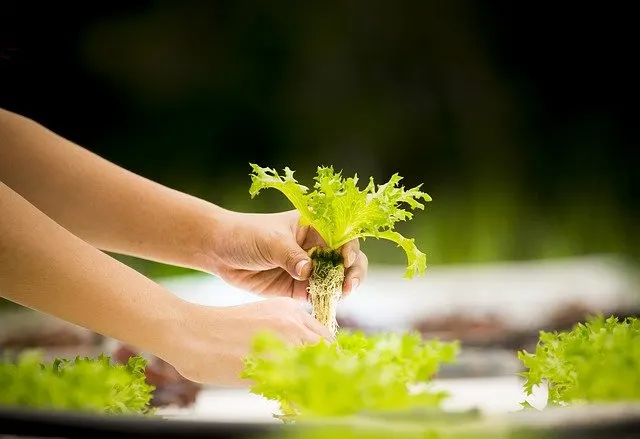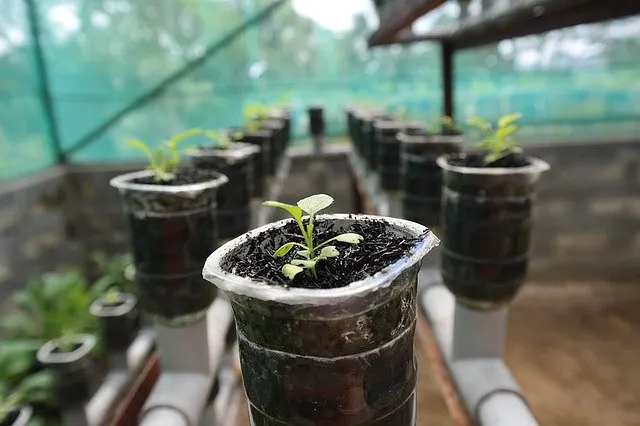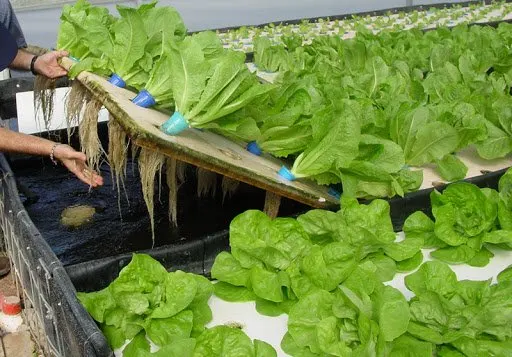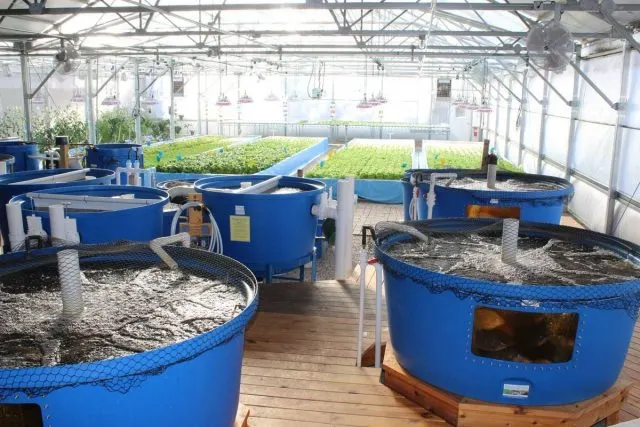Are you looking to do some indoor farming and wondering which system is best for you? Well, our hydroponics vs aquaponics systems guide, has all the answers you seek.
In recent years, it has become increasingly popular to grow plants in soilless systems. These modern systems present growers with more benefits than ancient methods.
Generally, there are two main systems common to growers, namely hydroponics and aquaponics. While the two are somewhat related, each system comes with its share of pros and cons.
Both hydroponics and aquaponics involve the growing of plants using water, without soil. With hydroponics, you inject formulated nutrient solutions directly into the water, for better growth of the plants.
But, in aquaponics, you feed your plants using organic matter produced by fish and other aquatic organisms like crayfish and snails.
To get a clear distinction between hydroponics vs aquaponics, let’s take an in-depth look at each system.
What is Hydroponics?

Hydroponics is a method of growing crops using water and chemical nutrients in the absence of soil. This production method is not only used in greenhouses to grow lettuce, basil, and tomatoes, but it is also a popular method among marijuana farmers.
While there’re numerous ways of designing a hydroponics system, the primary elements are the same. Here is what you need to set up a hydroponics system:
Things You Need to Set Up a Hydroponics System
1. Root Support
Your plants need something to attach to even though you don’t need soil. Some of the best materials to support your plants in a hydroponics system include the Rockwool, perlite, coconut fiber, vermiculite, and peat moss.
You should always avoid compacting materials such as sand, or anything that doesn’t retain moisture like gravel.
2. Clean Water
Most plants grow well in water with a PH level of between 6 and 6.5. You can adjust the acidity of your water-using various over-the-counter solutions, readily available at your local garden center, hydroponic store, or hardware.
3. Nutrients
Just like plants growing in the soil need fertilizers, plants growing in a hydroponics system also require plenty of minerals. Minerals like calcium, phosphorous, and magnesium will help ensure that your plants remain productive and healthy.
And since it might be hard to make your own nutrient mixtures, you’ll need to buy some, either online or from nearby stores
4. Oxygen
Oxygen is vital for the growth of any plant whether on soil or through a hydroponics system. While plants grown in the soil get oxygen from the soil through their roots, in hydroponics, you must introduce oxygen into the system.
This can be done either by leaving a space between the plant’s base and the water reservoir, introducing an air stone or by using an air pump.
5. Light
Always invest in special lighting when growing your plants indoors. Each kind of plant you intend to grow may come with a distinct requirement for the amount of light it needs. How you place the lighting also depends on the plants you’re growing.
Different Types of Hydroponics

There are different hydroponics methods that a grower can adapt with the most popular one being the Nutrient Film Technique (NFT). Here, vegetables are suspended with their roots, in a nutrient solution.
However, other methods do sometimes involve some other growing mediums such as sand, gravel, peat moss, or Rockwool. Such include the following.
- The Drip System – In this system, the nutrients solution is sent to the plant’s base using a pipe. This pipe contains a drip emitter at its tip, to regulate the amount of solution that the plants get.
- The Ebb and Flow System – Here, crops sit in a spacious tray containing a growing medium such as perlite or Rockwool. The tray or grow bed is then flooded with a nutrients solution, which is carefully drained to avoid overflow.
- The Water Culture system – in this system, plants are suspended in water without any other growing materials. An air stone or a diffuser is used to supply oxygen to the plant’s roots.
- The Wick System – this is the only hydroponics system that doesn’t use electricity. Plants are wrapped with a wick, before being inserted into the nutrient’s solution. The wick helps in drawing nutrients from the solution.
Main Pros of Hydroponics
Numerous commercial growers are shifting to hydroponic systems. The growing method touch on areas most people care about, such as food security and making the globe cleaner.
Additionally, different people worldwide buy their systems to grow fresh food for their families. Other advantages of using hydroponics to grow plants include the following.
Fewer Resources
Hydroponic systems use less water as opposed to ancient soil-based systems. This is because closed systems aren’t subject to the same rates of evaporation. Water in hydroponics systems can also be re-populated with nutrients, filtered, and fed back to the plants.
This means that the water is being recycled rather than wasted. In addition, indoor hydroponic plants are protected against various plant diseases and pests, thus requiring fewer pesticides.
Higher Harvests
Crops grown in a well-managed hydroponic system grow fast and healthy. The roots are submerged in all the nutrients they require.
This means that plants will have more time to grow upwards as they take less time and energy to spread their roots in search of nutrients – like in soil-based farming.
Although your plants’ growth rate depends on the type of system and quality of care, hydro crops mature faster, by around 25%, than soil-grown plants. Also, productivity is much higher.
Easy Troubleshooting
You may find some plants doing well while others are dragging behind, yet both are in the same garden. Well, when growing plants using a hydroponic system, you understand well the conditions that your plants are growing in.
This makes it easy for you to assess the nutrients, water PH levels, lighting, and any other factor that may be affecting the plants.
Easier Employee Training
Hydroponic systems are easy to teach and learn. The training process is straightforward since the systems are consistent and are less likely to experience issues.
Growers are recommended to create a training plan with steps that their employees will find easy to follow.
Creation of Jobs
Life becomes healthier and stable once people grow enough food for their families and the community at large.
Large hydroponic operations hire numerous employees to take care of maintenance, packaging, sales, shipping, and warehousing.
Major Cons of Hydroponic
Despite numerous advantages, the hydroponic system comes with its share of limitations. Some of these include:
Initial Setup Cost
You have to dig deeper in your pocket when setting up a hydroponic system for the first time. The required materials will always cost you, especially if it’s a big hydroponics project.
For example, you need to have to grow lights and ventilation as the two principal factors. Unlike soil farming, where you only need a spade, seeds, and some fertilizers, the hydroponic system needs more. You’ll need things, like nutrients solutions, reservoirs, pumps, and costly grow lights.
System Failures
When setting up your hydroponic system, it is essential to note that electricity and water don’t go well with each other. It’s, therefore, crucial to ensure that these two don’t meet.
Also, power blackouts and outages can be a challenge to hydroponic growers. Relying entirely on electricity may mean that the watering systems, lighting, and ventilation, won’t work when the power is out.
Additionally, if any piece of your system fails, for example, a water pump, your plant can wither easily if it’s not repaired fast.
Fast Spread of Water-borne Diseases
Since you are growing your crops in a closed system using water, pests and plant infections can escalate faster on the same nutrients reservoir. This is pretty common with huge hydroponic greenhouses if top-notch care is not maintained.
Requires Time and Commitment
This farming method requires your total attention and commitment. This means that you must spend time monitoring the plants and identifying any occurring issues. If not, you might not get the yields you expect.
What is Aquaponics?

Aquaponics is a farming method that combines aquaculture and hydroponics. Here, plants are grown in a symbiotic environment with aquatic organisms such as fish, snails, pawns, or crayfish.
Generally, nitrifying bacteria help to convert the waste produced by these animals, into nutrients used by the plants. In return, the plants clean the water, which is then recirculated to the fish in a closed system.
Basic Types of Aquaponics Systems
Plants in an aquaponics system need sufficient nutrients and excellent access to oxygen. In this light, aquaponics farmers have adopted various designs of aquaponics systems.
Some of the systems you can opt for include:
1. Media-based Grow Beds
In this aquaponics design, plants are grown in a 30cm deep bed of media, continuously flooded and drained with fish water. This guarantees a steady supply of fish waste from the fish tank, which is in return broken down by the nitrifying bacteria into plants’ nutrients.
2. Nutrient Film Transfer (NFT)
Here, a chain of pipes and trenches supply the nutrient-rich water from the fish tank to the plants. They are usually held in small pots comprising of sluggish material to offer physical support for the growing plants.
The systems are light and ideal when adopted for vertical growing. However, the system may need good back up pumping arrangements to support heavy plants and nutrients film.
3. Deep Water Culture (DWC)
In this aquaponics system design, plants are placed at regular intervals into a floating tranche. The roots grow downwards into the fish water to get nutrients. DWC is a popular system for large commercial farms.
Main Pros of Aquaponics
As a sustainable production system, aquaponics presents a series of merits to the grower and the environment. Here are the benefits of using this system:
Cost-effective
In an aquaponics system, your fish’s waste translates to your plant’s nutrients. This makes the method quite pocket friendly. Instead of spending money to buy nutrient-rich solutions, the aquatic animals help to manufacture the ideal nutrients for your plants.
The only cost here comes in feeding the fish. With the right type of food for your fish, your plants are guaranteed constant nutrients.
Enhanced Productivity
The most exciting aspect of aquaponics is the setting up of a fully sustainable growing environment. You will need less intervention once the relationship between your plants and fish is established.
Due to rich nutrients, your plants will likely grow rapidly and healthier, resulting in higher yields.
Minimal Use of Water
Compared to soil gardening, aquaponics consumes 90 percent less water. Moreover, an aquaponics system recycles water through the plants and the fish tank.
The only time that water is lost, is through evaporation from the fish tank once it’s uncovered.
Land conservation
Aquaponics systems produce two to six times more yields. This is because it allows multiple platforms on top of each other, and the plants also grow faster.
Through this farming method, you can cultivate and grow different crops in one location.
An Ideal Source of Income
Aquaponics creates a sustainable source of income. You can make handsome sales from both the plants and fish.
Major Cons of Aquaponics
Despite its immense merits, the aquaponics system comes with its share of disadvantages. Some of these may include:
High Electricity Usage
One of the cons of aquaponics is high electricity consumption. This is attributed to the fish tank that needs to be kept at a particular temperature 24/7.
However, if you will, you can invest in solar power to minimize these electricity costs.
Limited Crops
While the system is suitable for saltwater and freshwater species, like Tilapia, bass, and carp, the range of vegetables is limited. The system is ideal for a small range of crops such as cucumber and green leafy vegetables, including lettuce.
- Must be Professionally Installed
Although you can easily learn how to use this farming method, the system needs to be professionally installed, to avoid losses.
If your system is poorly-installed, there are higher chances of losing your crops or animals. Always seek the services of an expert, to avoid incurring losses.
See Related: Best Glass Greenhouses to Buy
Hydroponics vs Aquaponics: Similarities

Aquaponics is a combination of concepts from aquaculture and hydroponics. Therefore, both systems have numerous similarities that make them beneficial to a farmer.
Some of the well-known similarities include:
- You introduce nutrients to the crops artificially – either through nutrients solutions or aquatic animals.
- Both hydroponics and aquaponics systems are stable and produce high yields. This is because the plants grow in a controlled environment, less affected by adverse weather conditions.
- Both the hydroponics and aquaponics systems involve the growth of crops in water, in absence of soil.
- The two systems use less water and nutrients as compared to traditional farming methods.
- These two methods are less prone to pests and diseases, thus less use of pesticides and chemicals.
See Related: How to Start Growing Mushrooms in a Greenhouse
Hydroponics vs Aquaponics: Differences
Despite the many similarities between these two systems, there are also several notable differences.
Let’s take a look at the main differences between hydroponics and aquaponics methods.
- Hydroponics systems are pretty germ-free, as they need no growing media to support the plants or root systems. Aquaponics, on the other hand, needs a growing medium around the roots to harbor beneficial bacteria – this can become a breeding point for germs and disease.
- Hydroponics systems require you to buy nutrient solutions to add to your water, for healthier plants. In contrast, Aquaponics needs you to just feed the fish, and the rest will fit into play.
- Hydroponic growing systems are ideal for crops with high nutrient requirements, since the nutrient solution is modified to satisfy plant wants. Aquaponics systems are ideal for plants with lower nutrient requirements, such as lettuce, other leafy greens, and herbs.
See Related: Best Greenhouse Fans
Verdict: Aquaponics or Hydroponics?
Growing crops in soilless systems have gained traction over the past few decades. And with these two main methods, people are finding it easier to grow crops even in the most limited places. But, which of the two methods is better?
The answer to this question depends entirely on the person using the system, as well as how they want to use it. For instance, if you want to grow plants with a high demand for nutrients, hydroponics would be the best system for you.
On the other hand, if you are looking for the most cost-effective method, aquaponics takes the day. This is because you don’t have to keep buying nutrient solutions for the plants. The aquatic animals do the nutrients work for you.
For this reason, you should always evaluate your needs, before you decide which system to install. This hydroponics vs aquaponics guide, will in many ways, help you with that.
